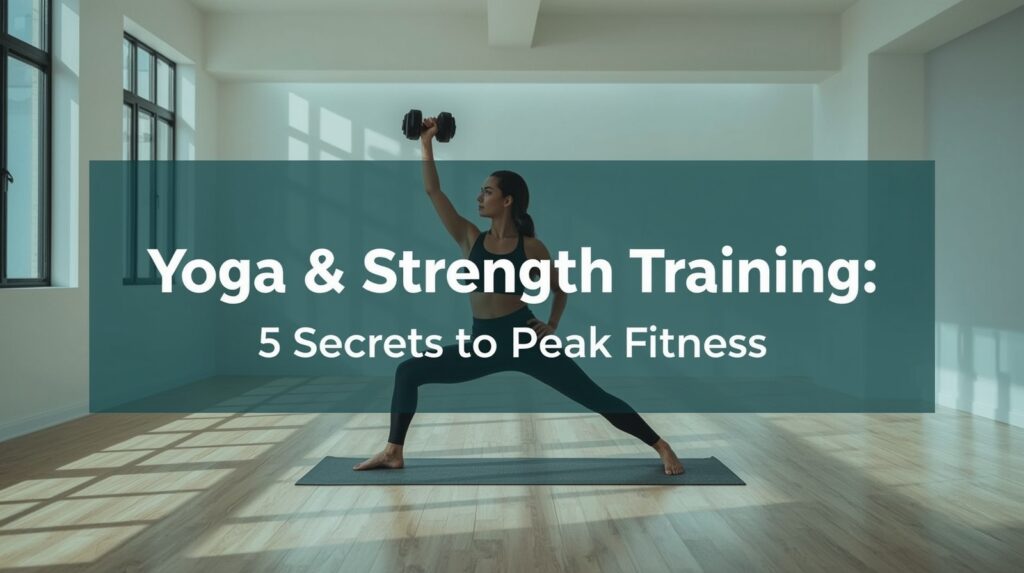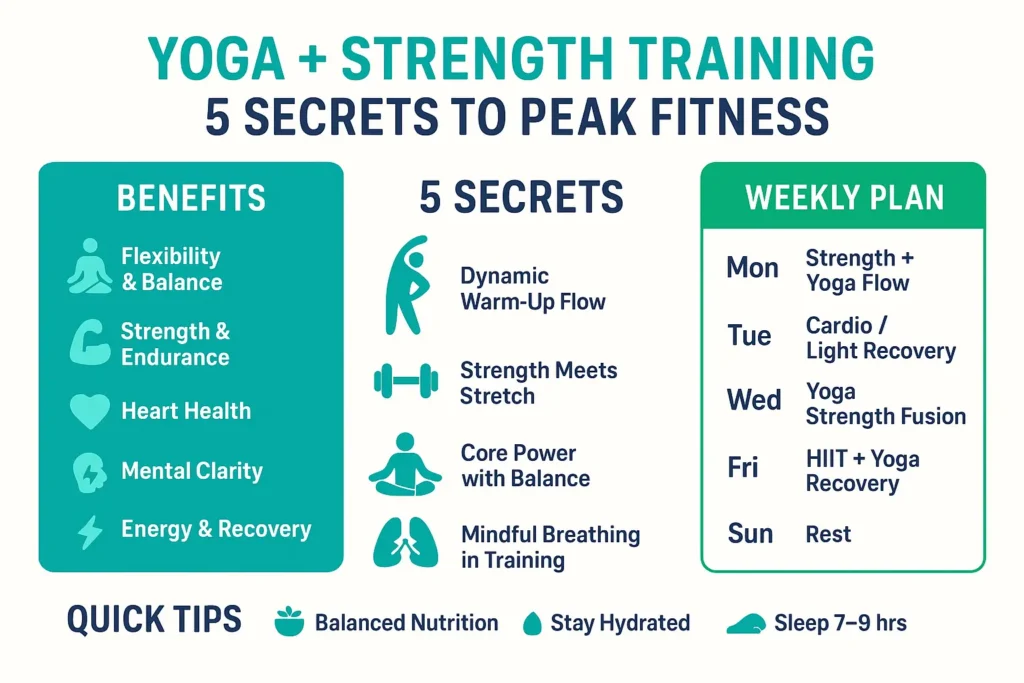-
Yoga and Strength Training: 5 Secrets to Peak Fitness
- Can Yoga Build Real Muscle Strength?
- 5 Secrets to Combining Yoga and Strength Training
- Benefits of Merging Yoga with Weight Training
- Best Yoga Poses to Enhance Strength Training
- Creating Your Weekly Yoga and Strength Training Routine
- Essential Nutrition Guidelines
- Common Mistakes to Avoid
- People Also Search For:
- Final thought
Yoga and Strength Training: 5 Secrets to Peak Fitness
Many people who want to be as fit as possible have to choose between yoga and strength training. But the real magic happens when these two strong practices come together. When you combine yoga with weight training, you get a whole-body approach that builds muscle, increases flexibility, and changes how well you can do things physically in ways that neither discipline can do on its own.
Yoga and strength training together aren’t just a fad; they’re a smart way to work out that fitness experts all over the world agree on. Strength training builds muscle and raw power, while yoga improves body awareness, flexibility, and mental clarity. They cover every part of physical health, from explosive strength to fine movement control. This detailed guide shares five tried-and-true tips that will help anyone learn how to combine these complementary practices for the best physical health and long-lasting results.

Can Yoga Build Real Muscle Strength?
Many people think that yoga is only about stretching and relaxing. However, some styles, such as power yoga, Ashtanga, and Vinyasa, help build muscle by using hard poses like Chaturanga or Warrior III.
Bodyweight exercises in yoga poses use your own body weight as resistance, but your strength gains usually stop after a while because you don’t get the progressive overload that comes from weight training. This is where synergy comes in: strength training builds muscle by putting mechanical stress on it, while yoga builds core strength and body awareness that help you lift better. Together, they make a complete system for building muscle and moving well.
5 Secrets to Combining Yoga and Strength Training
It’s not enough to just add yoga and strength training to your weekly schedule if you want to do both well. The key is to strategically combine things so that you get the most benefits without overtraining or getting hurt. These five proven tips show you how to combine resistance training and yoga for better strength, flexibility, and performance.
Secret 1 – Alternating Days for Maximum Recovery
The first secret to successfully combining yoga and strength training is to plan your workouts strategically. By alternating days, each discipline can work together instead of against each other, which keeps recovery from being too slow and results in being too low.
On days when you work out with weights, focus on progressive overload to make your muscles grow. It takes 48 to 72 hours for the mechanical stress to heal fully. A yoga day after heavy lifting is a way to recover actively and increase blood flow without putting too much stress on the muscles. This keeps the muscles fresh for peak performance and stops overtraining.
Secret 2 – Using Yoga as Your Dynamic Warm-Up
Adding a short yoga sequence as a warm-up gets the body ready more thoroughly than regular static stretching. Sun salutations, hip openers, and spinal twists are all part of a 10- to 15-minute flow that raises your heart rate and makes your joints more flexible.
This dynamic warm-up gets the core going, keeps the joints stable, and makes a mind-muscle connection that helps you lift correctly. Cat-cow and warrior poses get the spine ready, while warrior poses get the legs ready for squats or deadlifts. Athletes say they do better during strength training, which is when they move better and are less likely to get hurt.
Secret 3 – Strategic Cool-Down for Muscle Growth
Fitness programmes often forget about recovery after a workout. After working out, do a planned yoga cool-down to help your body recover and keep your muscles in an anabolic state so they can grow.
Gentle yoga poses for 10 to 20 minutes can help relax your muscles without hurting your training. Child’s Pose, Supine Twist, and Legs-Up-The-Wall are all restorative poses that help tissues heal and ease muscle soreness. Stretching while your muscles are still warm is a safe way to improve flexibility, which is the best way to stay stronger and more mobile.
Secret 4 – Core Activation Through Integrated Practice
The core is what connects yoga and strength training. Both yoga and strength training require strong cores, but they build them in different ways. Yoga focuses on isometric engagement during balance poses, while strength training focuses on anti-rotation and stability work under load.
Combining these methods leads to full core development. Boat Pose and other yoga poses help you build endurance, while squats and other compound exercises require you to be stable while moving. Yoga teaches you to be aware of your body, which helps you keep your core engaged when you lift heavy things, which protects your spine. Together, they make a strong core that helps with both sports and everyday tasks.
Secret 5 – Balance Overtraining and Undertraining
It is very important to find the right amount of training. A lot of people push themselves too hard by adding yoga to their already tough strength training, or they don’t train hard enough by replacing tough workouts with gentle yoga sessions. Think of yoga and strength training as one system.
This means being honest about how much stress and recovery you can handle during training. During weeks of hard strength training, focus yoga sessions on restoring your body instead of power yoga that pushes you. During deload weeks, doing vigorous yoga can keep the stimulus without putting stress on the joints. Pay attention to what your body is telling you. If you keep feeling sore or your performance drops, you need to make changes to avoid burnout and keep making progress over time.
Benefits of Merging Yoga with Weight Training
When you combine yoga and strength training, you get benefits that go far beyond what either practice can do on its own. Here are the main benefits:
- Enhanced flexibility and lifting mechanics: Yoga gives you more range of motion in your hips, shoulders, and ankles, which lets you do deeper squats, fuller overhead presses, and more efficient movement patterns that use more muscle fibres.
- Improved Mind-Muscle Connection: The body awareness you get from yoga makes your proprioception better when you lift weights. This helps people feel their target muscles working, which leads to better form and fewer compensation patterns, making strength training safer and more effective.
- Full Stress Management: Strength training helps relieve physical stress by releasing endorphins, and yoga helps relieve mental and emotional stress through breathing and being present. They work together to make a complete plan for dealing with life’s stressors.
- Faster Recovery and Injury Prevention: Yoga helps with the tight muscles and limited movement that come with heavy strength training while building muscle. Resistance training helps keep joints healthy and can help stop hyperextension injuries that can happen to advanced yoga practitioners.
- Balanced Physical Development: Strength training builds muscle mass and power that you can see, while yoga builds the subtle stabilisers, core strength, and movement quality that make fitness truly useful. This means better performance in sports, everyday tasks, and life in general.
Best Yoga Poses to Enhance Strength Training
Some yoga poses are great for strength training because they help you stay stable, move better, and activate important muscle groups. These basic poses make the muscles that are most important for lifting stronger and lower the risk of injury. Adding these exercises to your routine makes your approach to fitness more balanced and useful.
Warrior Poses for Lower Body Power
The Warrior sequence, which includes Warrior I, II, and III, is a great way to get ready for and help with lower-body exercises like squats and deadlifts. These strong poses have a lot of benefits:
- Builds Isometric Strength: This exercise strengthens the legs and opens the hips, which improves balance and adds to the explosive power gained from strength training.
- Activates Stabilising Muscles – Warrior II strengthens the external hip rotators and glutes, which are very important for keeping your body stable during heavy compound lifts.
- Improves the Quality of Movement: The balance needed for Warrior III activates smaller stabilising muscles in the legs and core, which makes lifting better overall.
People who regularly do warrior poses often say that they can squat deeper and hold their positions more steadily during single-leg exercises.
Plank Variations for Core Stability
Plank variations are the most important part of yoga-based core training that helps with strength training. Here are the reasons why they are so important:
- Anti-Extension and Anti-Rotation Strength: The traditional plank, side plank, and forearm plank build the stability needed to keep the spine in the right position while doing squats, deadlifts, and overhead presses.
- Dynamic Core Control: Advanced variations like plank with leg lifts or arm reaches teach the core to stay stiff while the limbs move on their own, which is exactly what you need to do during heavy compound exercises.
- Injury Prevention: Doing planks regularly greatly lowers the risk of lower back injuries by directly building the endurance and stability needed to keep good form during strength training sessions.
These positions help you lift better by mimicking the main demands of major lifts.
Chaturanga for Upper Body Strength
Chaturanga Dandasana, or Four-Limbed Staff Pose, is like a push-up for yoga, but it works your core even more. This strong pose has many benefits:
- Builds Upper Body Strength: This exercise builds a lot of power in the chest, shoulders, triceps, and core, which are all important muscle groups for upper body strength training.
- Improves Eccentric Control: The controlled lowering phase builds eccentric strength, which helps you control your muscles better when you do bench presses and other pushing movements.
- Strengthens Stabilisers: When done correctly, this exercise strengthens the rotator cuff and scapular stabilisers, which are often weak in people who only do traditional strength training.
- Teaches Full-Body Tension: You have to keep your body in a straight line from head to heels, like you do when you plank. This helps with compound lifts.
Chaturanga’s shoulder positioning strengthens the joints enough to safely support heavier pressing movements.
Creating Your Weekly Yoga and Strength Training Routine
To make a good weekly schedule, you need to find a balance between training and recovery. Here’s a method that works:
- Monday: Upper Body Strength Training. Do pressing and pulling exercises like bench presses, rows, and shoulder presses, and then do some yoga to cool down and stretch your upper body.
- Tuesday: Moderate Yoga Session: Focus on hip mobility and flexibility with flows that let the upper body recover while keeping the training going.
- Wednesday: Lower Body Strength Training: Do squats, deadlifts, and other leg exercises, and end with gentle yoga stretches for the lower body.
- Thursday—Active Recovery Yoga: Do restorative yoga or a light flow class to help your body adapt to the stress of the week’s training without putting more strain on your muscles.
- Friday: Upper Body Strength Training:Do different exercises or rep ranges for your upper body than you did on Monday to keep your progress going and make sure you are developing evenly.
- Saturday: Power Yoga or Vinyasa Flow. Do a hard yoga class that works your core and builds endurance without putting too much stress on your joints, like heavy weights do.
- Sunday: Full Rest or Gentle Yoga: Take a full day off or do some gentle yoga to help your body recover and get ready for the next week of training.

Essential Nutrition Guidelines
Good nutrition is important for both yoga and weight training to work well. Even the best-planned training programme won’t work if it doesn’t have enough fuel. To build muscle, recover from hard workouts, and keep your energy up during tough workouts, your body needs certain nutrients.
Protein intake: To help your muscles recover and grow, you should eat 0.8 to 1 gram of protein per pound of body weight every day.
Complex carbohydrates: Give you long-lasting energy for tough workouts and power for both yoga flows and heavy lifting.
Healthy fats help make hormones and keep joints healthy, which is important for sticking with your training over time.
Hydration: Important because both activities make you lose more fluids through sweat and breathing.
Timing of nutrients: For best performance, eat balanced meals 2–3 hours before working out. For faster recovery, eat post-workout nutrition within 30–60 minutes.
Whole Foods Foundation: The base should be high-quality whole foods, and supplements should only be used to fill in gaps when they are needed.
Common Mistakes to Avoid
Several common errors undermine the effectiveness of combining yoga and strength training:
- Doing both on the same day for long periods of time—this puts too much stress on the body’s ability to recover and leads to less than optimal results in both disciplines. Being tired from one practice makes the other one much less effective, which raises the risk of injury and lowers the quality of adaptation. Instead, do yoga on different days or use it as a warm-up or cool-down for intense strength training.
- Not using progressive overload in strength training—Some people get so caught up in the yoga part that they forget to gradually increase the weights or the intensity of their workouts. To build muscle, you need to gradually increase the amount of mechanical tension, which means regularly putting more weight or volume on the muscles. This progression is necessary for strength gains to continue, no matter how much yoga you do.
- Not taking any rest days at all—people who are really into both practices sometimes work out seven days a week without enough time to recover. Both yoga and strength training put stress on the body that needs time to adapt. The body goes into a state of chronic overtraining when it doesn’t get enough recovery days. This makes it more likely to get hurt and less likely to do well in both practices.
- Only doing gentle yoga styles—while restorative yoga is great for recovery, only doing gentle styles means you miss out on the strength-building benefits of more vigorous practices. Adding challenging power yoga or Vinyasa flows to your routine gives you more training stimulus that works with strength training without needing weights.
- Not paying attention to good nutrition—The combination of yoga and strength training greatly raises the body’s nutritional needs. Not getting enough protein makes it harder to build muscle, and not getting enough calories overall makes it harder to recover and perform. To support this integrated training approach, you need to pay attention to when you eat and make sure you have enough fuel for both practices.
People Also Search For:
Yes, combining yoga and exercise is highly beneficial and recommended by fitness experts. The best approach is alternating days—practise strength training one day and yoga the next—or use yoga as a warm-up or cool-down to your regular workouts for optimal results and recovery.
Alternate days between strength training and yoga to allow proper recovery, or use yoga as a warm-up before lifting and cool-down afterward. Listen to your body and take at least one full rest day weekly to prevent overtraining.
Schedule gym workouts and yoga on alternate days, or practice yoga as a 10-15 minute warm-up before gym sessions and cool-down afterward. This approach maximizes strength gains while improving flexibility and preventing injury.
Neither is inherently healthier—yoga excels at flexibility, balance, and stress relief, while weight lifting builds muscle, bone density, and metabolic health. Combining both practices delivers the most comprehensive health benefits for overall wellness.
Final thought
Yoga and strength training together are more than just adding two fitness activities together; it’s a system where each discipline helps the other. Resistance training builds strength that helps with more difficult yoga poses. Yoga, on the other hand, builds flexibility and body awareness that help with lifting and lower the risk of injury. This complementary relationship covers the whole range of physical fitness, from raw strength to the quality of small movements.
To be successful with this combined approach, you need to be patient, plan your workouts wisely, and pay attention to your recovery. Anyone can get the most out of both practices by following these five tips: planning your workouts strategically, using yoga as a warm-up and cool-down, building integrated core strength, and balancing the intensity of your workouts. The result is a long-lasting, all-around fitness plan that gives you a great body and a strong, capable body that is ready for any physical challenge life throws at you.
